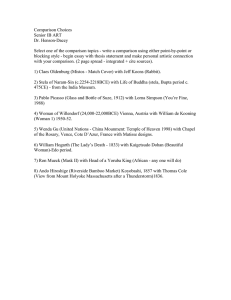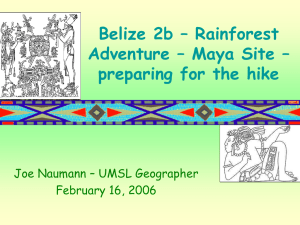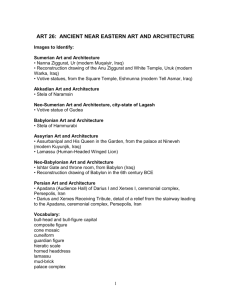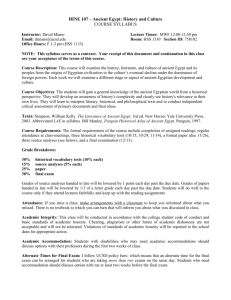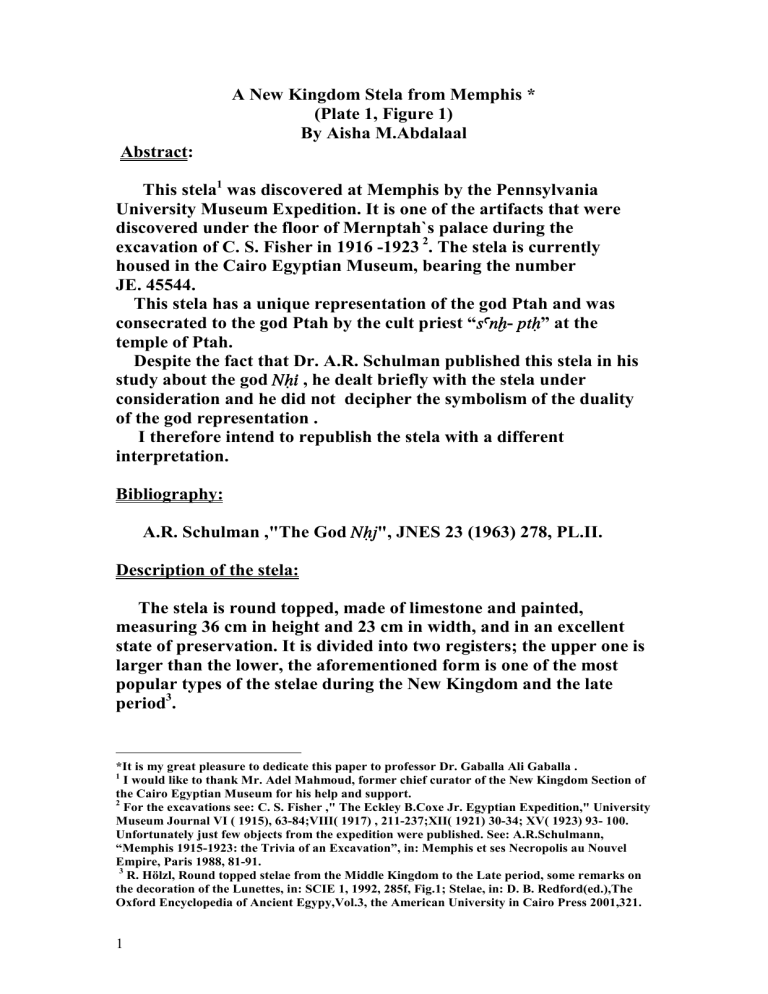
A New Kingdom Stela from Memphis * (Plate 1, Figure 1) By Aisha M.Abdalaal Abstract: This stela1 was discovered at Memphis by the Pennsylvania University Museum Expedition. It is one of the artifacts that were discovered under the floor of Mernptah`s palace during the excavation of C. S. Fisher in 1916 -1923 2. The stela is currently housed in the Cairo Egyptian Museum, bearing the number JE. 45544. This stela has a unique representation of the god Ptah and was consecrated to the god Ptah by the cult priest “sanx- ptH” at the temple of Ptah. Despite the fact that Dr. A.R. Schulman published this stela in his study about the god NHi , he dealt briefly with the stela under consideration and he did not decipher the symbolism of the duality of the god representation . I therefore intend to republish the stela with a different interpretation. Bibliography: A.R. Schulman ,"The God NHj", JNES 23 (1963) 278, PL.II. Description of the stela: The stela is round topped, made of limestone and painted, measuring 36 cm in height and 23 cm in width, and in an excellent state of preservation. It is divided into two registers; the upper one is larger than the lower, the aforementioned form is one of the most popular types of the stelae during the New Kingdom and the late period3. *It is my great pleasure to dedicate this paper to professor Dr. Gaballa Ali Gaballa . 1 I would like to thank Mr. Adel Mahmoud, former chief curator of the New Kingdom Section of the Cairo Egyptian Museum for his help and support. 2 For the excavations see: C. S. Fisher ," The Eckley B.Coxe Jr. Egyptian Expedition," University Museum Journal VI ( 1915), 63-84;VIII( 1917) , 211-237;XII( 1921) 30-34; XV( 1923) 93- 100. Unfortunately just few objects from the expedition were published. See: A.R.Schulmann, “Memphis 1915-1923: the Trivia of an Excavation”, in: Memphis et ses Necropolis au Nouvel Empire, Paris 1988, 81-91. 3 R. Hölzl, Round topped stelae from the Middle Kingdom to the Late period, some remarks on the decoration of the Lunettes, in: SCIE 1, 1992, 285f, Fig.1; Stelae, in: D. B. Redford(ed.),The Oxford Encyclopedia of Ancient Egypy,Vol.3, the American University in Cairo Press 2001,321. 1 The Scene: The lunette of the stela is occupied by a winged sun disc with no inner details, a common feature of the late period stelae4. This motif appeared first on the royal stelae and then it was transferred to private stelae starting from the end of the Middle Kingdom5. However, it became widespread and showing further elaboration of the motives during the New Kingdom6. The sun disc is one of the most commonly used symbols in the ancient Egyptian art. It guarantees divine protection for the deceased7, the light of the sun, and rebirth and resurrection in the Hereafter8. The main scene of our stela depicts two identical figures of the god Ptah facing each other. Ptah is depicted with his usual human form wrapped in a tight-fitting cloak, a tight cap embodying his head, a large collar with its counterweight hanging down his back, and holding the wAs scepter in his two hands9, a symbol – usually carried by deities and kings-symbolizing power and authority. He has long straight beard, and standing on the mAat sign. Depicting two figures of the god facing each others which it was usual to represent each god in the middle of the stela facing the opposite side10. Therefore our stela is quite unique in its style. The two figures are separated by a tall offering table laden with three conical loaves of bread11. Behind the god to the left side of the stela, stands a man with his arms raised in adoration12. 4 E.M. Stewart, Egyptian Stelae, Reliefs and Paintings, part Three: the Late Period, England 1983, Pl. 8.11;10.17;16.28;17.34;19.44. 5 A. M. Abdalaal, The Private Funerary Stelae of the Middle Kingdom (The Cairo Museum Collection) unpublished MA Thesis submitted to the Faculty of Archaeology, Cairo University 1995 ( in Arabic ),110,194. 6 The winged sun disk appears in different shapes during the Middle and New Kingdom. It could be schematic and full of details. For complete commentary about this point see, R. Hölzl , op-cit. I, 1992,288; throughout the first half of 18th Dynasty we find that the sun disk was common on royal and private stelae when it was used on the private stelae. It appeared above the figures of deities or kings. H.M.Stewart, op-cit., I, P.VIII; we may note few examples from New Kingdom for such motif compare: M.L.Bierbrier (ed.), The British Museum Hieroglyphic Texts from Egyptian Stelae etc. V 1914, PL.44; VI 1922, PL.30,44; XII 1983, PL.96. 7 D.Wildung, Flűgelsonne, in: LÄ. II, 1977, 278. 8 W.Westendorf, Altaägyptische Darstellungen des Sonnenlaufes auf der abschüssigen Himmelsbahn, in: MÄS10, 1966, 24; A.Radwan, Darstellungen der aufgehenden Sonne auf einigen Stelen der Ramessidenzeit, in: Festschrift W.Westendorf, Göttingen 1984, 824, 827. 9 For different forms of Ptah; see: Sandman Holmberg, The God Ptah, (London 1946),p12-17. 10 Cf: CGC.34013, 34025, 34026. 11 This type of offering tables is well known at least since the end of twelfth Dynasty and it became so commonly used after that. Cf: A. M. Abdalaal, op-cit., fig. 48,74. 12 The attitude of a worshipper standing with his hands raised is one of three main different positions, see: A.I. Sadek, Popular Religion in Egypt during the New Kingdom, HÄB 27, 1988 ,200 f. 2 The worshipper appears gracefully tall and slim, a feature that was common during the Ramesside period13. He puts on short hair and wears a short tight skirt. He has a thin tall face with almondshaped eyes, a very delicate nose and mouth. As for his neck, it is somehow tall and full. It is worth noting that the ear is small, fleshy and prominent, but it seems carved a little bit higher than normal; a common feature that appears in art especially during the reign of Seti I and Ramesses II14. All the above mentioned features help dating this stela to the Ramesside period15. The Text: (see Fig.1) (1) Under the winged sun disk there is an L - reversed shaped text, in sunk relief: ↓→ PtH aA pHty nb kA(w)aSA (w).f → PtH nb smn mAat Ptah the most great of strength, patron of his numerous KAs (spirits) Ptah lord of smn-mAat b. (2) The lower part of the stela is occupied by one line of sunk horizontal hieroglyphs, a common feature known from the first half of the eighteenth Dynasty stelae16. → Hnwty n pr ptH sanx (ptH). The cult priest C of Ptah`s Temple Se-ankh (Ptah)17. 13 Cf : M.L.Bierbrier (ed.),op-cit. ,1983,Pl.76;XII 1993,Pl. 60-61,64-65; P.J.Brand, The Monuments of Seti 1, Epigraphic, Historical and Art Historical Analysis, Brill 2000, Fig.1-2,90, 18,23-24,34-35,42,50-51,76; see also E. Russmann, Eternal Egypt Masterworks of ancient art from the British Museum, the British Museum Press 2001,192(Cat.. no.92); Compare also A.Radwan, Six Ramesside stelae in the popular pyramidion-form, in: Extrait des ASAE. LXXI,1987,Pls.I,IV, P.227. 14 P.J.Brand, op-cit., Fig. 36-7, 54,67,95-6, 101, 123-4; W.J.Murnane, P.J.Brand, J.Karkowski, and R.Jaeschke, The Karnak Hypostyle Hall Project 9(1992-202), in : ASAE 78, 2004, Fig.5 A , 14 b, Fig.19 , 25,37,42-3, 49; G.T.Martin,Stelae from Egypt and Nubia in the Fitzwilliam Museum ,Cambridge 2005, No.47 Acc. Ess.31; M.Jørgensen, Catalogue Egypt II(1550- 1080 B.C.) Ny Carlsberg Glyptotek 1998, 69, 79, 94, 95, 100, 102, 106. 15 Supra 13-14. 16 Cf: Hieroglyphic Texts from Egyptian Stelae, V, Pl.20, VII, Pl34; S. Bostico, Stele egiziane del Nuovo Regno, II, Rom 1965, 19-20, No.8N ; S. Hodjash and O. Berliv, The Egyptian reliefs and Stelae, in the Pushkin Museum of Fine Arts, Moscow, Leningrad 1982, 9089, Fig.45; CGC.34004, Pl.IV,34029, Pl. XXII, 34056, Pl.XXXIII, 34058, Pl.XXXV,34060, 34061, Pl.XXXVI , 34076,Pl. XXXIX, 34086,Pl.XLII, 34125, Pl.LIV, 34150,Pl.LX . 17 PN I, 300 - 22. Shulmann mentioned that: “the name is to be read sanx ptH, since Ptah was already written in the title of the owner iHwty n pr ptH , the second writing of Ptah was omitted” A.R. Schulman, op-cit., 279. 3 Comment: (a) Schulman did not give an explanation for the unique representation of god Ptah, mentioned that this stela could be one of the strongest arguments against the equation NHi = ptah 18. The scene represented on our stela could be interpreted as follows: The owner of the stela presents prayers to the local manifestation of the god Ptah pth nb smn mAat as a mediator between himself and the great god of Memphis. The concept of a person praying to his local god for help was common during the New Kingdom. Except that mediation was usually expressed on stelae by means of a person praying to the divine living king19, or the divine deceased kings, or respecting a high-ranking personality, whether alive or dead20. (b)smn mAat : This term is believed to refer to a small town in which the god Ptah was worshipped within the Memphite region21, to the south- east of the main temple of Ptah 22. (c) Hnwty : Schulman read the title as iHwty “meaning farmer” 23 owing to the confusion which occurred during the 18th Dynasty between the sign M2 " Hn" and the sign T24 "iH, aH" and the absence of the latter from most of the hieratic texts of the New Kingdom. 18 Ibid., 277f; K.Sethe , Dramatische Texte zu altaegyptischen Mysterienspielen , in: Untersuchungen zur Geschichte und Altertumskunde Aegyptens ; X ( 1964),76; This equation was not accepted with reasonable facts by Sandman see : Sandman Holmberg, op-cit., 178 f. 19 Radwan,A., Ramsses II As Mediator, in: Monographs of the Institute of Egyptian Art and Archaeology I, Memphis 1991, 221-226.;ThotmosisIII. Als Gött, in: Stationen. Beiträge zur Kulturgeschichte Ägyptens Fs. R. Stadelmann, Mainz 1998, 329- 340. 20 A.I. Sadek, op-cit.,107, 229-233. 21 A.R. Schulman ,"The God Nhj", in : JNES 23 ( 1963) 278; WB. IV ,133 28. 22 Bergman, J. Ich bin Isis : Studien zum memphitischen Hintergrund der griechischen Isisaretalogien, in: Acta Universitatis Upsaliensis, Historia Religionum 3, 1968, 257f. 23 Schulmman,R.,op.cit.,279(21) ;For iHwty see: Gardiner, “Ramesside Texts Relating to the Taxation and Transport of Corn” JEA 27 (1941) 21f ; AEO, I, No . 226.; WB.I, 214 7-9. 4 Consequently, the hieratic sign was wrongly transcribed as , especially in the title iHwty "farmer: 24. In our stela the reading Hnwty is more plausible and would be translate as “cult priest” 25 a translation which agrees with the philosophical idea of mediation of the scene in questions. It is worth noting, that it is generally known that funerary stelae were produced in great number in the workshops, and then the name of the worshipper was added later when he bought his own copy. Our case seems to be different as the topic of mediation using two manifestations of the same god is - according to our knowledge – new. Therefore, we can assume that the idea depicted here was a special request from the part of the owner of the stela. Conclusion: The feature of the deceased together with the simple form of the stela assigns it to the Ramesside era. The Scene shows a unique representation of the two manifestation of the god Ptah, expressing the idea of mediation in an unusual style. 24 Gardiner, A., Egyptian Grammar,3rd ed. Oxford 1979,478; see also: Möller , G., Hieratische Paläographie : die ägyptische Buchschrift in ihrer Entwicklung von der funften Dynastie bis zur römischen Kaiserzeit , 2vols., Leipzig 1927, 268, 463 . 25 Hannig, R. Grosses Handwörterbuch Deutsch-Ägyptisch : (2800-950 v. Chr.) : die Sprache der Pharaonen , Mainz : Verlag Philipp Von Zabern, c2000, 536, 607. 5 Plate 1 6 Stela of sanx ptH JE. 45544. Fig. 1 7 Stela of sanx ptH JE. 45544. 8
